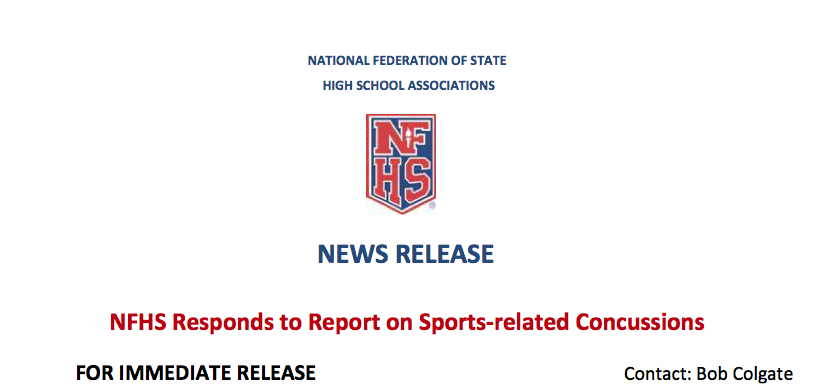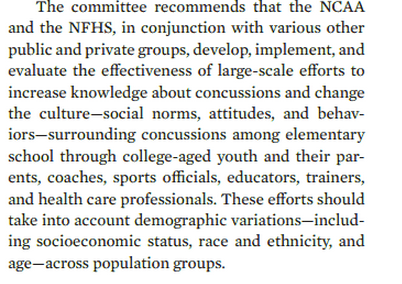NFHS responds to the IOM/NRC Concussion Report
After reading the IOM Concussion Report yesterday which put the NCAA and the NFHS in a leadership role, I called the NFHS to see what they thought about the report and how they viewed their role in the future.
I left a message for Bob Colgate, Director of Sports and Sports Medicine, National Federation of State High School Associations (NFHS) and Bob called me back today. I appreciate Bob taking the time to speak to me on a number of aspects about concussion including the online NFHS Concussion Training Course and NATIONAL HIGH SCHOOL SPORTS-RELATED INJURY SURVEILLANCE STUDY. We both agreed on the importance of concussion education for coaches, parents, school staff, and students - all students - not just student-athletes.
Bob then emailed me with the following press release: NFHS Responds to Concussion Report. Please see my follow-up questions/comments following the press release.

INDIANAPOLIS, IN (November 1, 2013) — On October 29, the Institute of Medicine (IOM) and the National Research Council (NRC) released a detailed report on “Sports-Related Concussions in Youth – Improving the Science, Changing the Culture.”
The National Federation of State High School Associations (NFHS), which has been a leader among national sports organizations in the area of concussion awareness and management the past five years, fully cooperated with the preparation of the report and is in support of many of the report’s recommendations.
“We support the report’s conclusion that a culture change is a national priority,” said Bob Gardner, NFHS executive director. “Concussions are not ‘dings’ – they are serious medical conditions that need to be addressed. I am pleased to report that the NFHS places its highest priority on risk minimization for the 7.7 million participants in high school sports.”
In 2008, the NFHS Sports Medicine Advisory Committee advocated that a concussed athlete shall be immediately removed from play and not return until cleared by an appropriate health-care professional. For the past four years, all NFHS rules publications have contained guidelines for the management of an athlete exhibiting signs, symptoms or behaviors consistent with a concussion.
In addition, with help from the Centers for Disease Control (CDC), the NFHS developed a free, 20-minute online course “Concussion in Sports – What You Need to Know.” More than 1.2
million administrators, coaches, officials, athletes, parents and health-care professionals have taken the course since 2010. (See www.nfhslearn.com)
The NFHS also agrees that injury surveillance is important to help prevent future injuries. Since 2005, the National High School Sports-Related Injury Surveillance Study (High School RIO), commissioned by the NFHS and compiled by Dr. Dawn Comstock, principal investigator from the Pediatric Injury Prevention, Education and Research (PIPER) program at the Colorado School of Public Health and Colorado Children’s Hospital in Aurora, Colorado, has been collecting injury surveillance data for the NFHS. (visit http://www.ucdenver.edu/academics/colleges/PublicHealth/research/ResearchProjects/piper/projects/ RIO/Pages/Study-Reports.aspx for the full reports.)
The NFHS also works with the National Center for Catastrophic Sports Injury Research (NCCSIR) at the University of North Carolina-Chapel Hill, which has been collecting catastrophic injury data on all sports for more than 35 years.
“The NFHS strives to minimize risk for all high school athletes in all sports,” Gardner said. “The athletic community – administrators, coaches, officials, athletes, parents and health- care professionals – should know that this support system of rules, education and research exists to provide a safer environment for all athletes in all sports. We hope the report will encourage all these leaders in the high school athletic community to recognize and respond more effectively to concussions.”
### About the National Federation of State High School Associations (NFHS)
The NFHS, based in Indianapolis, Indiana, is the national leadership organization for high school sports and performing arts activities. Since 1920, the NFHS has led the development of education-based interscholastic sports and performing arts activities that help students succeed in their lives. The NFHS sets direction for the future by building awareness and support, improving the participation experience, establishing consistent standards and rules for competition, and helping those who oversee high school sports and activities. The NFHS writes playing rules for 17 sports for boys and girls at the high school level. Through its 50 member state associations and the District of Columbia, the NFHS reaches more than 19,000 high schools and 11 million participants in high school activity programs, including more than 7.7 million in high school sports. As the recognized national authority on interscholastic activity programs, the NFHS conducts national meetings; sanctions interstate events; offers online publications and services for high school coaches and officials; sponsors professional organizations for high school coaches, officials, speech and debate coaches, and music adjudicators; serves as the national source for interscholastic coach training; and serves as a national information resource of interscholastic athletics and activities. For more information, visit the NFHS Web site at www.nfhs.org.
Bruce Howard, 317-972-6900 Director of Publications and Communications National Federation of State High School Associations bhoward@nfhs.org
Chris Boone, 317-972-6900 Assistant Director of Publications and Communications National Federation of State High School Associations cboone@nfhs.org
Questions I have after reading the release and have emailed Bob Colgate for clarification:
1. From this statement, "The National Federation of State High School Associations (NFHS)... fully cooperated with the preparation of the report and is in support of many of the report’s recommendations," can I take that the NFHS doesn't completely agree with "all" the recommendations?
What parts of the IOM report are not supported by the NFHS and which are supported by the NFHS?
2. I read the IOM committee's recommendation that the "NCAA and NFHS (in conjunction with others..) develop, implement, and evaluate" as if the current efforts of concussions education/training/research efforts are not enough, and in the future, the NCAA and NFHS would lead the way with new "large-scale efforts."
The statement from NFHS press release states all that the NFHS has done (which is very commendable) but it "appears" by saying "We hope the report will encourage all these leaders in the high school athletic community to recognize and respond more effectively to concussions,” seems that the buck is passed to the high schools themselves.
Is the NFHS going to initiate any new programs or initiatives based on what was learned in the IOM report?
Is there anyway for the NFHS to hold high schools accountable or reward the schools to make the changes needed?
...
We have been waiting for a year the IOM report and the APP report which is a clear blueprint for schools to follow. So now with these reports in hand along with the various concussion online trainings, and variety of education flyers, who is going to lead the way and how?
The IOM recommends the NCAA and NFHS as for the job of leading schools and sports organizations. The NFHS press release states what they have already been doing.
What can the NFHS really do beyond supplying its members with info (which they have already done) and funding the data collection of injury rates (which they are doing)?
I realized it is a balancing act for organizations which rely on voluntary members to require/demand their membership meet certain standards. I have talked with Steve Stenersen, President of US Lacrosse, over the years on the issues of carrot or stick with concussion education/training and youth lacrosse organizations. There are really no sticks to use with members who can leave your organization, and carrots cost money.
Note: From my read, the IOM Report does not suggest any source of funding for any organization to use to pay for any of the recommendations the report suggests. It is hard to be passed the command without the funds to pay the troops.
- Could there be an answer in the NFHS accrediting a high school with a NFHS "concussion-prepared," or "concussion-savy" stamp of approval when a school hires full time ATs and trains coaches, staff, parents and students?
- Could a seal of approval from the NFHS be something for the schools to strive for to be the "highest level" of prepared a school can be (in the concussion field which is still developing)?
- Would parents value this standard and pressure schools who did not meet the standard?
Concussion education isn't hard to understand, and the resources exist to teach coaches, parents and students. What is missing is the commitment of overburdened schools, sports organization and parents to make the time to attend the classes or complete the online trainings or read the flyers. We need leaders now find ways to ensure education takes place, to encourage individual states to update their concussion laws with mandatory requirements, and find sources of funding so the needed research is done.

